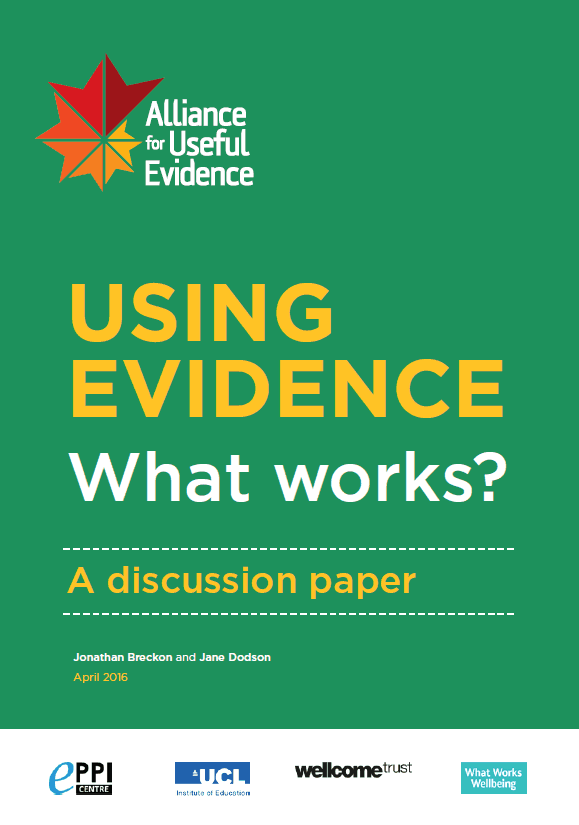Using Evidence: What Works?
Downloads

Intro
The Alliance for Useful Evidence has joined forces with the Wellcome Trust, the What Works Centre for Wellbeing, and the EPPI-Centre at University College London (UCL) to uncover the evidence on what works to enable research use.
Overview
So what exactly are the best ways of getting research used by decision-makers? Evidence rarely speaks for itself. It can need an extra nudge, or a helping-hand to reach, say, the primary school classroom, or a Whitehall Departmental Board.
You may have witnessed some impressive ways for research to get noticed and used. Maybe a high-level policy seminar, mentoring programme or a journal club used by nurses. But do they really work? Our pet approaches to knowledge exchange may fail to deliver, and we need to evaluate if they really cause impact. There’s a consensus, for instance, that it’s a good thing to make researchers work side-by-side with decision-makers. Such joint working sounds like a noble cause. But, as we will see in this paper, there is no large body of high quality evidence to support the faith in interactions between researchers and users.
It’s easy to feel bamboozled by all the methods to change people’s motivation, capacity or opportunity to use research. We identified over 150 possible interventions from the research literature. It’s an enormous range, including behavioural ‘nudges’, professional development, social marketing, and much more.
A whole industry has risen to help find more ways to link research to practice. We have journals studying the area, such as Evidence and Policy and Implementation Science. We have dedicated organisations like Research in Practice, the Public Coordinating Centre for Public Engagement, and Research to Action. We have networks promoting the cause, such as the European Implementation Network, the Africa Evidence Network, and the Alliance for Useful Evidence. There has been a recent push for new organisations to synthesise actionable research for decision-makers, such as the What Works Centres in the UK, and the What Works Cities4 in the US.
For somebody new to the area and looking for pointers on what to focus on, there are toolkits, checklists and guides.
The framework
Briefly, six underlying mechanisms of enabling research use in decision-making were drawn from the literature,7 and used to group the interventions studied. These are summarised below:

In reality, these mechanisms are often combined and are used together. However, there were two exceptions: ‘Skills’ and ‘Access and Communication’ were applied by themselves in some of the interventions, so the study was also able to look at how both these worked in isolation.
The following section introduces key findings from each review on what works, what doesn’t, and what’s promising in terms of ways to enable the use of research.
Under each of the six sections, the findings from Review 1 and Review 2 are set out. Review 1 looked at the impact on enabling evidence use, and Review 2 looked at what we could learn from the wider social science literature.
![]()
[gravityform id=1 title=true description=true ajax=true tabindex=49]
